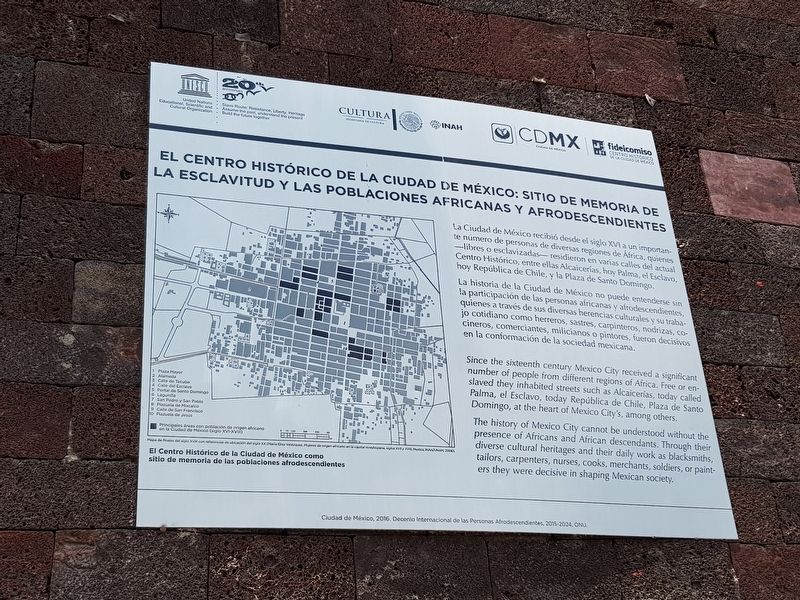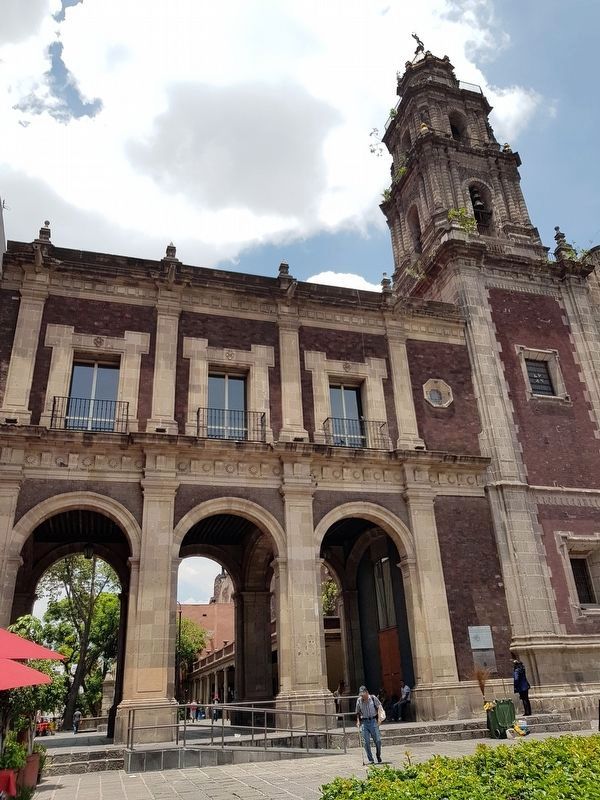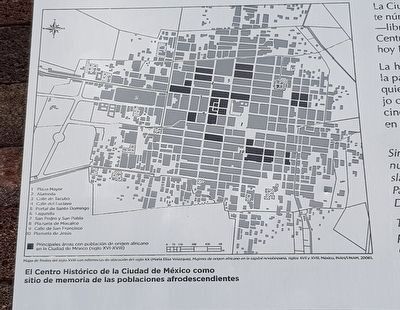Centro Histórico in Ciudad de México, Mexico — The Valley of Mexico (The Central Highlands)
A Memorial Site to Slavery and African Populations and Descendants
The Historic Center of Mexico City
Inscription.
La Ciudad de México recibió desde el siglo XVI a un importante número de personas de diversas regiones de África, quienes - libres o esclavizadas - residieron en varias calles del actual Centro Histórico, entre ellas Alcaicerías, hoy Palma, el Esclavo, hoy República de Chile, y la Plaza de Santo Domingo.
La historia de la Ciudad de México no puede entenderse sin la participación de las personas africanas y afrodescendientes, quienes a través de sus diversas herencias culturales y su trabajo cotidiano como herreros, sastres, carpinteros, nodrizas, cocineros, comerciantes, milicianos o pintores, fueron decisivos en la conformación de la sociedad mexicana.
Pie de dibujos: Principales áreas con población de origen africano en la Ciudad de México (siglo XVI-XVIII)
Mapa de finales del siglo XVIII con referencias de ubicación del siglo XX (María Elisa Velázquez, Mujeres de origen africano en la capital novohispana, siglos XVII y XVIII, México, INAH/UNAM, 2006).
Ciudad de México, 2016, Dececio Internacional de las Personas Afrodescendientes, 2015-2024, ONU.
The Historic Center of Mexico City: A memorial site to slavery and African populations and descendants
Since the sixteenth century Mexico City received a significant number of people from different regions of Africa. Free or enslaved they inhabited streets such as Alcaicerías, today called Palma, el Esclavo, today República de Chile, Plaza de Santo Domingo, at the heart of Mexico City's, among others.
The history of Mexico City cannot be understood without the presence of Africans and African descendants. Through their diverse cultural heritages and their daily work as blacksmiths, tailors, carpenters, nurses, cooks, merchants, soldiers, or painters they were decisive in shaping Mexican society.
Captions: The main areas with a population of African origin in Mexico City (16th-18th century)
Map of the late 18th century with reference to 20th century locations (María Elisa Velázquez, Women of African origin in the Mexican capital of New Spain, XVII and XVIII centuries, Mexico, INAH / UNAM, 2006).
Mexico City, 2016, International Year of People of African Descent, 2015-2024, UN.
Erected 2016 by Secretaría de la Cultura, Instituto Nacional de Antropología e Historia
(INAH).
Topics. This historical marker is listed in these topic lists: African Americans • Colonial Era • Industry & Commerce. A significant historical year for this entry is 2016.
Location. 19° 26.295′ N, 99° 8.032′ W. Marker is in Ciudad de México. It is in Centro Histórico. Marker is on República de Brasil just north of Calle República de Venezuela, on the left when traveling north. Touch for map. Marker is at or near this postal address: República de Brasil 44, Ciudad de México 06000, Mexico. Touch for directions.
Other nearby markers. At least 8 other markers are within walking distance of this marker. The Beginning of the Camino Real de Tierra Adentro (here, next to this marker); Temple of Santo Domingo (a few steps from this marker); Servando Teresa de Mier (within shouting distance of this marker); Chapel of the Expiration (within shouting distance of this marker); Leona Vicario de Quintana Roo (within shouting distance of this marker); Plaza and Portal of Santo Domingo (within shouting distance of this marker); Salón Madrid (within shouting distance of this marker); Ex-Palace of the Inquisition (within shouting distance of this marker). Touch for a list and map of all markers in Ciudad de México.
Credits. This page was last revised on April 17, 2020. It was originally submitted on August 21, 2018, by J. Makali Bruton of Accra, Ghana. This page has been viewed 167 times since then and 11 times this year. Photos: 1, 2, 3. submitted on August 21, 2018, by J. Makali Bruton of Accra, Ghana.


